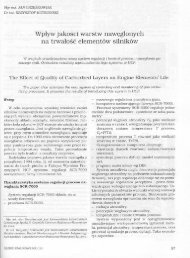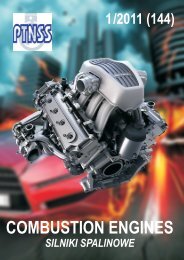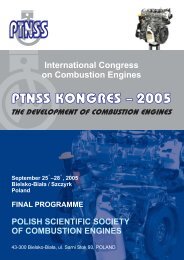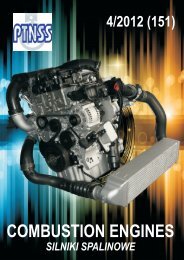Create successful ePaper yourself
Turn your PDF publications into a flip-book with our unique Google optimized e-Paper software.
Analiza procesu spalania w przemysłowych silnikach gazowych...<br />
Fig. 5. Indicating diagram of a 12 cylinder, two-stroke gas engine, fuel – high methane, fuel valve with swirl, left side – for 12 cylinders, right side –<br />
for a single cylinder<br />
Rys. 5. Wykres indykatorowy dwunastocylindrowego, dwusuwowego silnika gazowego, gaz paliwowy – wysokometanowy, zawór paliwowy z zawirowaniem,<br />
lewa strona – dla 12 cylindrów, prawa strona – dla pojedynczego cylindra<br />
produces higher homogeneity of the fuel mixture with a drop<br />
in emissions of unburned hydrocarbons.<br />
After the engine was modified, emissions of toxic compounds<br />
and pollutants were measured (Fig. 6) as well as the<br />
temperature of exhaust gases after the turbocharger.<br />
A quantitative analysis of the composition of exhaust<br />
gases shows a clear relation between emissions of NO, CO<br />
and C x<br />
H y<br />
and the coefficient of excess air λ. The lowering<br />
of the molar fraction of oxygen in the fuel mixture<br />
brings about the lowering of the adiabatic<br />
temperature of combustion, which in turn leads<br />
to a reduction of the thermal dissociation of molecular<br />
oxygen into atomic oxygen. This reduces<br />
the amount of nitric oxides formed in reaction<br />
(1), (2) i (3). As λ increases, there is a decrease<br />
of the temperature of exhaust gases exiting the<br />
engine.<br />
Gas engine Waukesha AT<br />
Combustion of lean mixtures of gas fuels is<br />
a difficult task, and thus, in modern gas engines,<br />
technologies are used to remedy this, such as<br />
micro-pilot, i.e. the injection of a small pilot dose<br />
of diesel fuel or a prechamber. The objective is to<br />
facilitate the ignition of the fuel mixture. This is<br />
particularly important in combustion of fuels with<br />
a large content of inert gases, such as nitrogen or<br />
carbon dioxide.<br />
The analysed gas engines Waukesha AT have,<br />
as standard equipment, a prechamber (Fig. 7). Rich<br />
mixture is fed into the prechamber, where ignition<br />
by an electric spark occurs; then hot exhaust gases<br />
produced by the combustion of this “ignition mixture” initiate<br />
the ignition of the lean mixture in the cylinder.<br />
Lean fuel mixture is fed into the cylinder by an inlet<br />
system during the intake stroke. Measurements for fourstroke<br />
engines were carried out for two types of fuel gas:<br />
high-methane and nitrified low-calorific. The measured<br />
parameters were, like in the case of the two-stroke engine,<br />
Analizowane silniki gazowe Waukesha AT zostały seryjnie<br />
wyposażone w komorę wstępną (rys. 7). Do komory<br />
wstępnej doprowadzana jest bogata mieszanka, której zapłon<br />
następuje od iskry elektrycznej, następnie gorące spaliny<br />
powstałe w wyniku spalania tej mieszanki inicjują zapłon<br />
ubogiej mieszanki znajdującej się w cylindrze.<br />
Uboga mieszanka palna doprowadzana jest do cylindra<br />
układem dolotowym w trakcie suwu dolotu. Pomiary<br />
Fig. 6. Analysis of the exhaust gases composition for Cooper-Bessemer GMVH-12, fuel<br />
– high methane<br />
Rys. 6. Wyniki analizy składu spalin dla Cooper-Bessemer GMVH-12, gaz paliwowy<br />
– wysokometanowy<br />
silników czterosuwowych wykonano dla dwóch rodzajów<br />
paliwa gazowego: wysokometanowe i zaazotowane niskokaloryczne.<br />
Wielkościami mierzonymi, podobnie jak dla<br />
silników dwusuwowych, były emisje związków toksycznych<br />
i zanieczyszczeń emitowanych do atmosfery. Przykładowe<br />
rezultaty pomiarów przedstawiono na rys. 8 i 9. Zależność<br />
emisji NO i CO od współczynnika nadmiaru powietrza jest<br />
48 <strong>COMBUSTION</strong> <strong>ENGINES</strong>, No. 1/2013 (152)












